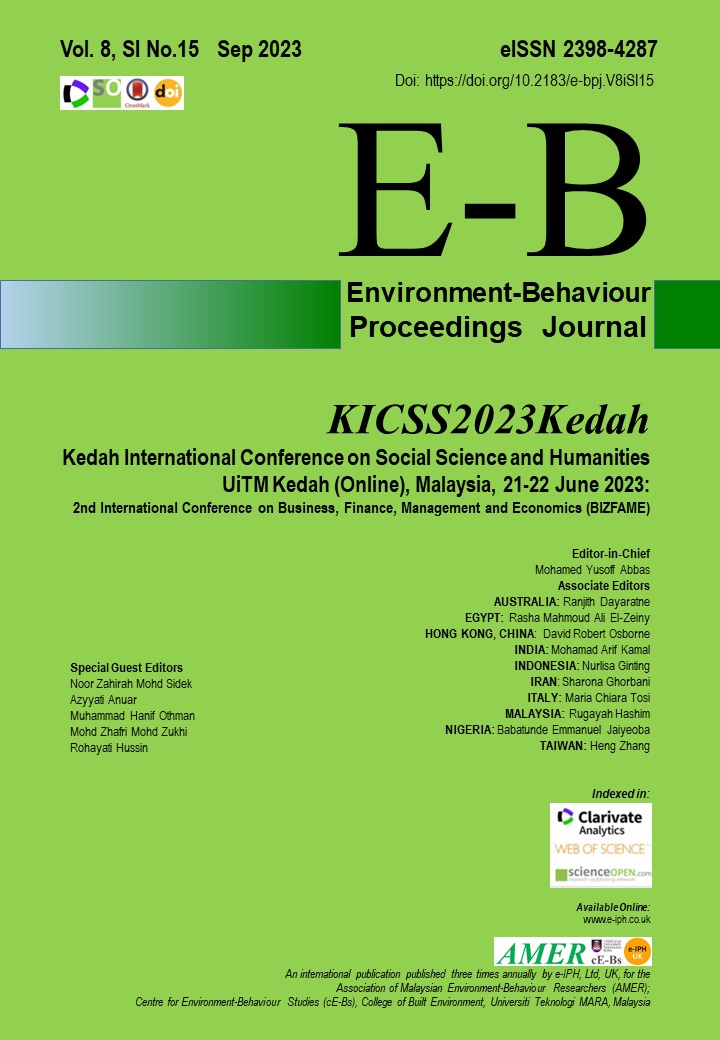Do they Intend to save? Saving behaviour intention among urban dwellers from low-income households
DOI:
https://doi.org/10.21834/e-bpj.v8iSI15.5102Keywords:
Savings Behaviour Intention, Attitude Towards Saving, Subjective Norm, Perceived Behavioural ControlAbstract
This study examines the level of saving behaviour intention among the households. Motivated by Ajzen’s Theory of Planned Behaviour framework, this study also examines the main factor affecting the households’ saving behaviour intention. A total of 148 questionnaires were distributed, and the data collected was analyzed using a descriptive and inferential statistics to meet the objectives of the study. The results suggest a low level of saving behaviour intention among the low-income households. The results also indicate that financial literacy was found to be the main factor influencing saving behaviour intention among the households.
References
Ahmad, N. W., Yunus, M. M., Baharudin, N. A., Johari, N., & Ripain, N. (2015, May). Determinant of Saving Behavior among Staff in International Islamic University College Selangor. In International Conference on Economics and Banking (ice-15). Atlantis Press DOI: https://doi.org/10.2991/iceb-15.2015.35
Byrne, B. (2006). Structural equation modeling with EQS: Basic concepts, applications, and programming. Mahwah, NJ: Erlbaum
Brounen, D., Koedijk, K. G., & Pownall, R. A. (2016). Household financial planning and savings behavior. Journal of International Money and Finance, 69, 95-107. DOI: https://doi.org/10.1016/j.jimonfin.2016.06.011
Celcer, S. (2020, October 29). World Savings Day: Gross household saving rate in Slovenia is higher than the euro area average for the third consecutive year. Retrieved from https://www.stat.si/StatWeb/pr/News/Index/9111
Delafrooz, N., & Paim, L. (2015). Personal Saving Behavior among Malaysian Employees: Socio-Demographic Comparison Ministry of Women, Family, and Community Development, (2011). National Policy for Older Persons, 2011.
Dharmarathna W.M.K.T. & Kumari D.A.T. (2021) Factors Affecting Young Customers’ Saving Intention: An Integrative Review in Sri Lankan Context Asian J. Interdicip. Res. 1 -14 Volume 4, Issue 2, Year 2021, DOI: 10.34256/ajir2121 https://www.researchgate.net/publication/350821540_Factors_Affecting_Young_Customers'_Saving_Intention_An_Integrative_Review_in_Sri_Lankan_Context DOI: https://doi.org/10.34256/ajir2121
Hair, J. F., Black, W. C., Babin, B. J., & Anderson, R. E. (2010). Multivariate Data Analysis (7th Edition). NJ: Prentice Hall.
Hussein, K., Mohieldin, M., & Rostom, A. (2017). Savings, financial development, and economic growth in the Arab Republic of Egypt revisited. The World Bank DOI: https://doi.org/10.1596/1813-9450-8020
Ismail, S., Khairuddin, N. S., Alias, N. E., Loon-Koe, W., & Othman, R. (2018). An Empirical Analysis of Saving Behavior among Malaysian Employees. International Journal of Academic Research in business and Social Sciences, 8(10), 1070–1080 https://www.researchgate.net/publication/334253650_An_Empirical_Analysis_of_Saving_Behavior_among_Malaysian_Employees [accessed May 27 2023]. DOI: https://doi.org/10.6007/IJARBSS/v8-i10/4822
Ismail, S., Koe, W. L., Mahphoth, M. H., Karim, R. A., Yusof, N., & Ismail, S. (2020). Saving Behavior Determinants in Malaysia: An Empirical Investigation. KnE Social Sciences, 731-743. DOI: https://doi.org/10.18502/kss.v4i6.6639
Kusairi, S., Sanusi, N. A., Muhamad, S., Shukri, M., & Zamri, N. (2019). Financial Households' Efficacy, Risk Preference, And Saving Behaviour: Lessons From Lower-Income Households In Malaysia. Economics & Sociology, 12(2), 301-318 DOI: https://doi.org/10.14254/2071-789X.2019/12-2/18
Mensahklo, E., Kornu, D. D., & Dom, B. (2017). An Empirical Analysis of the Determinants of Saving Behaviour by Households in Ho, Ghana: A Case Study of Ho Municipality, An Individual Level Analysis. Retrieved from https://core.ac.uk/download/pdf/234647814.pdf
OECD (2021), Household savings (indicator). doi: 10.1787/cfc6f499-en (Accessed on 11 May 2021) DOI: https://doi.org/10.1787/cfc6f499-en
Ringgit Plus. (2020). Malaysian Financial Literacy Survey 2020. Retrieved from https://www.fenetwork.my/wp-content/uploads/2020/11/RinggitPlus-Financial-Literacy-Survey-Full-Report.pdf
Stuart. H. & Sherman D. H.,(2015) Individual and Institutional Factors Related to Low-Income Household Saving Behavior. Journal of Financial Counseling and Planning, Vol. 26, No. 2, 2015, Available at SSRN: https://ssrn.com/abstract=2589976 DOI: https://doi.org/10.1891/1052-3073.26.2.187
Tharanika K. & Andrew. A., (2017) Factors Influencing On Saving Behaviour Among University Students- With Special Reference to the Students of Faculty Of Commerce and Management, Eastern University, Sri Lanka International, Journal of Research Available at https://edupediapublications.org/journals Volume 04 Issue 14 November 2017
The World Bank. (2019). Gross domestic savings (% of GDP) - Macao SAR,China.https://data.worldbank.org
Ventura, L. (2021, January 25). Household Saving Rates 2021. Retrieved from https://www.gfmag.com/global-data/economic-data/916lqg-household-saving-rates
Widjaja, I., Arifin, A., & Setini, M. (2020). The effects of financial literacy and subjective norms on saving behavior. Management Science Letters, 10(15), 3635-3642 DOI: https://doi.org/10.5267/j.msl.2020.6.030
.
Downloads
Published
How to Cite
Issue
Section
License
Copyright (c) 2023 Mohd Nazir Rabun, Nur Nabilah Ahmad Marzuki, Nursalam Abd Mutalib, Muhammad Hanif Othman

This work is licensed under a Creative Commons Attribution-NonCommercial-NoDerivatives 4.0 International License.





